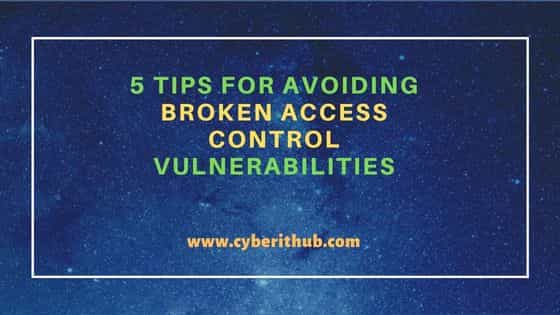Table of Contents

In today’s digital world, the safety and integrity of your applications and data have never been more important. With cyber threats constantly evolving, one critical aspect that developers need to pay attention to is access control vulnerabilities.
One of the most alarming flaws is broken access control, a widespread yet often overlooked issue that poses a significant risk to an organization’s information security.
To help safeguard against such threats, we have compiled a list of five essential tips for avoiding broken access control vulnerabilities.
Implementing and understanding these key strategies helps web and app developers, IT managers, and security professionals alike take the imperative steps required to provide the robust protection of their digital assets and maintain the trust of their users.
What Is Broken Access Control?
Broken access control is a type of security vulnerability that happens when an application’s access control system fails to stop users from gaining access to data or functionality they are not supposed to.
It can happen due to many factors:
- Insecure access control policies
- Insufficient authentication
- Poor authorization logic
For example, a user might obtain confidential information by changing the URL, making authentication tokens, or taking advantage of session management flaws.
Broken access control is a critical vulnerability since:
- It could bring about serious security threats. These include unauthorized data exposure, falsification of data, and escalated privileges.
- It goes against the fundamental security principle of least privilege, which ensures that users have only the minimum necessary authorization level to carry out their jobs.

Prevent Broken Access Control in 5 Ways
Software developers must implement strong access control mechanisms and regularly examine their projects for access control vulnerabilities.
These include:
1. Implement the Principle of Least Privilege (PoLP)
The principle of least privilege (PoLP) is a cybersecurity approach that grants users and services access to only as much information and privilege as they need to function. By enacting this principle, organizations can limit the damage caused by an accidental or deliberate misuse of resources, reducing risks such as data breaches or malicious activity.
Successfully implementing this principle within an organization requires dedication from all levels of staff.
- Top-level management should set policy guidelines and ensure that others adhere to them.
- Developers should design systems with PoLP in mind from the start.
- System administrators must keep track of user privileges and monitor behavior for suspicious activities.
Common strategies for implementing the principle of least privilege are:
- Establishing tenant admins with limited permissions responsible for the environment within their departments
- Enforcing strict password requirements
- Monitoring user activity closely
2. Use Role-Based Access Control (RBAC)
As its name suggests, role-based access control (RBAC) grants or restricts user access to a system based on roles assigned.
For example, a company’s HR department may grant employees access to only their assigned payroll records, while restricting them from viewing other employees’ information.
RBAC is a popular security model because of it:-
- Enables organizations to manage user privileges quickly and easily
- Simplifies system maintenance since changes made to one role propagates to all users associated with it
- Defines which users are allowed to access particular resources in the system
- Can be used to limit what each user is capable of doing
The responsibility for implementing RBAC typically falls on the system administrator, who creates roles with specific rights and assigns them to users accordingly.
While RBAC offers an efficient way of managing access within an organization, it has some limitations, such as difficulty incorporating dynamic changes or scalability issues.
Organizations can implement additional measures to overcome these limitations, such as using fine-grained access control mechanisms like Group Policy Objects (GPOs) or Attribute-Based Access Control (ABAC).

3. Regularly Conduct Security Audit
Another practical method of preventing broken access control is to perform regular security audits. Here is how to do it:
- Define the scope of the audit and any relevant standards or regulations.
- Determine an appropriate audit methodology, such as a manual review or automated scan.
- Identify vulnerabilities and assess the impact of each on access control.
- Provide recommendations for remediation.
- Conduct ongoing monitoring and review of the system to help ensure baseline security requirements are met.
4. Employ Proper Session Management Techniques
Many security breaches, including broken access control, occur because of simple but common issues, such as the failure to securely log in and out. The problem compounds when the user accesses the organization’s files or systems in public places.
To prevent this, organizations must ensure that their session management techniques are reliable and secure, such as:
- Establishing session IDs that are difficult to guess, unique to each user, and sufficiently strong
- Ensuring that a user’s session ID is securely stored in the browser and is not accessible or modifiable by third-parties
- Using encrypted cookies as an additional layer of security when storing session information
- Setting specific expiration dates for sessions and refreshing them regularly
- Enforcing a secure logout process that clears active sessions upon sign out
- Implementing multi-factor authentication for stronger authentication
5. Implement Access Control Checks at All Levels
Implementing access control checks across all layers of an application ensures full security and protection from malicious actors. This should include checks for authentication, authorization, and data integrity at the:
- User interface (UI)
- Application programming interfaces (APIs)
- Backend systems
Implement these checks at each stage during the software development lifecycle, including design, coding, testing, and deployment. Developers should also take steps to review the codebase thoroughly at each stage to identify any weaknesses or possible issues early on.
Additionally, developers should adopt secure coding practices. These include avoiding hard-coded secrets and using a secure database encryption algorithm to store sensitive data.
Preventing broken access control guarantees the integrity and security of your organization’s systems and resources. Following the guidelines can strengthen the access control system and minimize the risk of a breach.

